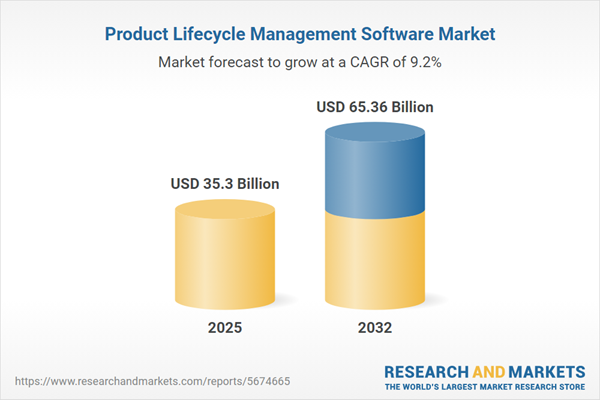Speak directly to the analyst to clarify any post sales queries you may have.
Senior executives seeking to optimize innovation, compliance, and operational excellence in product-driven industries increasingly view Product Lifecycle Management software as a crucial foundation for digital transformation and sustained competitive advantage.
Market Snapshot: Product Lifecycle Management Software Market
The Product Lifecycle Management Software Market grew from USD 32.29 billion in 2024 to USD 35.30 billion in 2025. With a compound annual growth rate (CAGR) of 9.21%, it is expected to reach USD 65.36 billion by 2032. This growth reflects expanding enterprise demand for platforms that unify data, accelerate product launches, and streamline regulatory processes.
Scope & Segmentation
This report delivers a structured analysis across core dimensions shaping the global PLM software landscape:
- Component: Services, including consulting and support & maintenance, and Software, such as analytics tools, core PLM suites, and integration modules.
- Deployment: Cloud-based and on-premises solutions, supporting flexibility, scalability, and regulatory preference.
- Application: Change management, design collaboration, product data management, and quality management—including both product quality planning and supplier quality management.
- Industry Verticals: Aerospace & defense, automotive, industrial manufacturing, and medical devices reflect varying adoption drivers and complexities.
- Organization Size: Large enterprises value seamless integration with core enterprise systems, while small and medium businesses prioritize modular, scalable deployments.
- Regional Breakdown: Comprehensive coverage includes Americas (North and Latin America), EMEA (Europe, Middle East, Africa), and Asia-Pacific, spotlighting growth patterns in established, transitioning, and emerging markets.
- Leading Vendors: Competitive analysis includes Siemens Digital Industries Software, Dassault Systèmes SE, PTC Inc., SAP SE, Oracle Corporation, Autodesk, IBM, Aras Corporation, Infor, and IFS AB.
Key Takeaways for Product Lifecycle Management Software Market
- Modern PLM platforms break down traditional organizational silos, enabling real-time collaboration between engineering, manufacturing, quality, and service teams.
- Advancements in artificial intelligence and digital twin technologies empower predictive analytics, proactive risk mitigation, and more efficient resource allocation.
- Cloud migration supports scalable and cost-efficient PLM deployments, fostering agile responses to dynamic business and regulatory needs.
- Growing pressure for sustainability and evolving regulatory requirements are driving integrated compliance solutions and lifecycle assessment tools within PLM ecosystems.
- Vendor competition centers on offering end-to-end digital thread capability and ensuring seamless interoperability with existing ERP and CAD infrastructures.
- Regional market opportunities are shaped by demand for operational agility in Asia-Pacific, established digitalization in North America, and sustainability priorities in Europe.
Tariff Impact: Navigating Shifting Trade Policies
United States tariff adjustments in 2025 have increased the cost of hardware required for PLM deployments, prompting enterprises to consider cloud options. Software vendors are rebalancing pricing models to manage higher support costs, shifting toward subscriptions that help buyers maintain budget stability. These changes have also impacted hardware component sourcing, with enterprises turning to alternative suppliers and risk frameworks to ensure continuity and resilience across PLM value chains.
Methodology & Data Sources
This analysis leverages a blend of secondary research—covering industry reports, regulatory guidelines, and academic findings—and primary research, including executive interviews and end-user surveys. Quantitative survey results were validated through expert workshops and data triangulation, upholding methodological rigor and integrity throughout each phase of the study.
Why This Report Matters for Decision-Makers
- Enables strategic investment by identifying emerging technology trends, regulatory shifts, and market expansion opportunities across verticals and regions.
- Supports risk mitigation, operational improvement, and informed vendor selection by providing deep segmentation and actionable competitive intelligence.
- Guides organizations in aligning PLM deployment models and features with evolving business requirements and global compliance standards.
Conclusion
The Product Lifecycle Management Software Market is transforming enterprise product strategies by integrating advanced technology, compliance, and collaboration. This report equips leaders with the clarity to adapt, invest, and succeed within an increasingly complex global environment.
Additional Product Information:
- Purchase of this report includes 1 year online access with quarterly updates.
- This report can be updated on request. Please contact our Customer Experience team using the Ask a Question widget on our website.
Table of Contents
3. Executive Summary
4. Market Overview
7. Cumulative Impact of Artificial Intelligence 2025
Companies Mentioned
The companies profiled in this Product Lifecycle Management Software market report include:- Siemens Digital Industries Software, Inc.
- Dassault Systèmes SE
- PTC Inc.
- SAP SE
- Oracle Corporation
- Autodesk, Inc.
- International Business Machines Corporation
- Aras Corporation
- Infor, Inc.
- IFS AB
Table Information
| Report Attribute | Details |
|---|---|
| No. of Pages | 193 |
| Published | October 2025 |
| Forecast Period | 2025 - 2032 |
| Estimated Market Value ( USD | $ 35.3 Billion |
| Forecasted Market Value ( USD | $ 65.36 Billion |
| Compound Annual Growth Rate | 9.2% |
| Regions Covered | Global |
| No. of Companies Mentioned | 11 |









